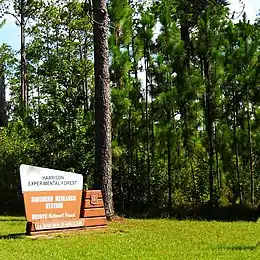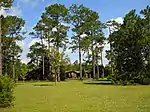| Harrison Experimental Forest | |
|---|---|
 Highway entrance sign at the Harrison Experimental Forest headquarters | |
 Location in Mississippi  Location in United States | |
| Location | Harrison County, Mississippi, United States |
| Nearest city | Gulfport, Mississippi |
| Coordinates | 30°37′36″N 89°03′18″W / 30.62667°N 89.05500°W[1] |
| Area | 4,107 acres (1,662 ha)[1] |
| Established | July 19, 1934[1] |
| Governing body | USFS, Southern Research Station |
Harrison Experimental Forest is an experimental forest facility operated by the Southern Research Station (SRS) of the United States Forest Service in Harrison County, Mississippi. The experimental forest is located within the De Soto National Forest about 25 mi (40 km) north of Gulfport, Mississippi off Old Mississippi Highway 67.[2][3]
History
Before construction of railroads and establishment of settlements in the southern United States in the latter half of the 19th century, the longleaf pine ecosystem (Pinus palustris) dominated the landscape and extended from Virginia south and west into East Texas through nine US states, covering an area of more than 140,000 sq mi (360,000 km2).[4] Numerous sawmill communities sprang up along newly constructed railroads to meet the increasing demand for processed lumber. By the 1930s, this vast resource of virgin pines had been depleted in south Mississippi.[5] Although the land was excellent for pine growth, the poor soils of south Mississippi proved to be worthless for growing agricultural row crops, thus creating a barren landscape.[6]
In an effort to conserve these cutover lands, the US government bought up thousands of acres in south Mississippi under the Weeks Act during the 1930s.[7] These lands were consolidated into what would become the De Soto National Forest. In 1933, a tract of 3,850 acres (1,560 ha) was set aside as the Harrison Experimental Forest for conducting long-term silvicultural research.[6]

By 1934, numerous buildings – a residence, office/lab, greenhouse, equipment depot, and garage – were under construction or had been completed on the experimental forest by the Civil Works Administration. Concurrently, the Civilian Conservation Corps landscaped the grounds at the headquarters area and constructed fences plus more than 11 mi (18 km) of roads on the experimental forest.[6]
Research
The earliest research studies conducted on the experimental forest were related to forest fire behavior and wood preservation.[8]: 28–29 By 1939, researchers at the experimental forest were the first to have initiated the use of water spray as a preservative for log storage at sawmills.[8]: 28–29 Researchers were also credited with developing preservative treatment of wooden fence posts to increase their longevity.[8]: 28–29
Other major areas of research on the experimental forest included studies of pathological diseases. In the late 1940s, research was initiated into brown-spot needle blight (Mycosphaerella dearnessii) in longleaf pine, fusiform rust (Cronartium fusiforme) in loblolly (Pinus taeda) and slash (Pinus elliottii) pines, littleleaf disease (Phytophthora cinnamomi) in shortleaf (Pinus echinata) pines and black root rot (Macrophomina phaseolina) of pine seedlings in nurseries.[9]
In the 1950s, the main focus of research at the experimental forest evolved to address problems associated with matching tree seed sources to sites in need of regeneration.[2]
Southern Institute of Forest Genetics


In 1954, the Southern Forest Experiment Station announced that the Harrison Experimental Forest would become home to the Southern Institute of Forest Genetics.[10]: 128–129 Formal dedication of the Institute was held at the experimental forest on March 3, 1955. By 1960, a new laboratory facility opened in Gulfport, MS to house project scientists, but actual field research continued at the experimental forest.[6]
During the 1970s, the Gulfport facility housed 19 scientists who investigated genetics and disease resistance.[11] In 1992, the Gulfport facility closed because of changing budget priorities; by then, scientists had relocated to the Harrison Experimental Forest.[6][12]
In 2022, the mission of the Research Work Unit at the Harrison Experimental Forest was:
To advance the scientific understanding of the roles of genetics, environment, and their interactions to provide guidelines and tools for improving the sustainable productivity of southern forest ecosystems.[13]
Research Natural Area
The Harrison Research Natural Area was established in 1989 and encompasses 180 acres (73 ha) within the Harrison Experimental Forest.[14] When assessed in 1991, 90% of the overstory component was an undisturbed stand of longleaf pines that seeded naturally during clearcutting in the 1920s.[14]
Gallery
Harrison Experimental Forest headquarters area
 Headquarters facilities
Headquarters facilities Administrative building
Administrative building Greenhouse facilities
Greenhouse facilities
References
- 1 2 3 "Experimental Forests of the Southern Research Station". ArcGIS StoryMaps. Retrieved Jul 29, 2022.
- 1 2 "Experimental Forests and Ranges (EFR) Network | Locations | SRS|Harrison". www.srs.fs.usda.gov. Retrieved 2022-07-29.
- ↑ "Forest Genetics and Ecosystems Biology | SRS". www.srs.fs.usda.gov. Retrieved 2022-07-29.
- ↑ "Longleaf Pine Ecosystem". 2010-04-17. Archived from the original on 2010-04-17. Retrieved 2022-07-31.
- ↑ Hoyle, Zoё (October 8, 2015). "The Harrison Experimental Forest|Pine genetics comes of age". srs.fs.usda.gov/compass. Retrieved 2022-07-31.
- 1 2 3 4 5 "United States Forest Service, Harrison Experimental Forest Station Collection". lib.usm.edu. 1925–1998. Retrieved 2022-07-29.
- ↑ Williams, Gerald W. (March 29, 2003). "PRIVATE PROPERTY TO PUBLIC PROPERTY: THE BEGINNINGS OF THE NATIONAL FORESTS IN THE SOUTH" (PDF). npshistory.com. Retrieved 2022-08-02.
- 1 2 3 The Ohio State University, Knowlton School of Architecture (January 2, 2008). "Harrison County Scenic Byway Corridor Management Plan for State Highway 67" (PDF). Mississippi Scenic Byways Program.
- ↑ Verrall, Arthur F. (October 1977). "Obituary|Paul Victor Siggers, 1889-1977" (PDF). Phytopathology. 67 (10): 1173 – via apsnet.org.
- ↑ Carter, Mason C.; Kellison, Robert C.; Wallinger, R. Scott (Nov 9, 2015). Forestry in the U.S. South: A History. LSU Press. ISBN 9780807160558. Retrieved Aug 1, 2022 – via Google Books.
- ↑ "Collection: Berch Henry collection | Welcome to the Mississippi State University Libraries". msstate-archives.libraryhost.com. Retrieved Aug 1, 2022.
- ↑ Isebrands, J.G.; Zalesny Jr., R.S. (2021). "Reflections on the contributions of Populus research at Rhinelander, Wisconsin, USA" (PDF). Can. J. For. Res. 51 (2): 139–153. doi:10.1139/cjfr-2020-0248. S2CID 225261305.
- ↑ "About Us | Forest Genetics and Ecosystems Biology | SRS". www.srs.fs.usda.gov. Retrieved Aug 1, 2022.
- 1 2 "ArcGIS Web Application". usfs.maps.arcgis.com. Retrieved 2022-08-02.
External links
 Media related to Harrison Experimental Forest at Wikimedia Commons
Media related to Harrison Experimental Forest at Wikimedia Commons- Forest Genetics and Ecosystems Biology Publications (1962–2022)